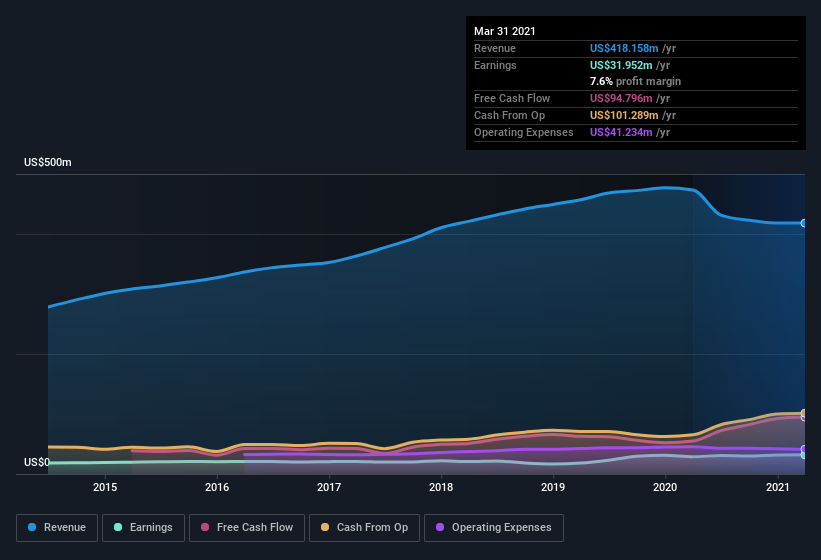Do U.S. Physical Therapy's (NYSE:USPH) Earnings Warrant Your Attention?
It's only natural that many investors, especially those who are new to the game, prefer to buy shares in 'sexy' stocks with a good story, even if those businesses lose money. Unfortunately, high risk investments often have little probability of ever paying off, and many investors pay a price to learn their lesson.
If, on the other hand, you like companies that have revenue, and even earn profits, then you may well be interested in U.S. Physical Therapy (NYSE:USPH). Now, I'm not saying that the stock is necessarily undervalued today; but I can't shake an appreciation for the profitability of the business itself. Loss-making companies are always racing against time to reach financial sustainability, but time is often a friend of the profitable company, especially if it is growing.
Check out our latest analysis for U.S. Physical Therapy
U.S. Physical Therapy's Earnings Per Share Are Growing.
If a company can keep growing earnings per share (EPS) long enough, its share price will eventually follow. That makes EPS growth an attractive quality for any company. We can see that in the last three years U.S. Physical Therapy grew its EPS by 15% per year. That growth rate is fairly good, assuming the company can keep it up.
I like to see top-line growth as an indication that growth is sustainable, and I look for a high earnings before interest and taxation (EBIT) margin to point to a competitive moat (though some companies with low margins also have moats). Not all of U.S. Physical Therapy's revenue this year is revenue from operations, so keep in mind the revenue and margin numbers I've used might not be the best representation of the underlying business. U.S. Physical Therapy's EBIT margins have actually improved by 2.6 percentage points in the last year, to reach 15%, but, on the flip side, revenue was down 12%. That falls short of ideal.
You can take a look at the company's revenue and earnings growth trend, in the chart below. Click on the chart to see the exact numbers.
Fortunately, we've got access to analyst forecasts of U.S. Physical Therapy's future profits. You can do your own forecasts without looking, or you can take a peek at what the professionals are predicting.
Are U.S. Physical Therapy Insiders Aligned With All Shareholders?
I like company leaders to have some skin in the game, so to speak, because it increases alignment of incentives between the people running the business, and its true owners. As a result, I'm encouraged by the fact that insiders own U.S. Physical Therapy shares worth a considerable sum. Indeed, they hold US$28m worth of its stock. That's a lot of money, and no small incentive to work hard. Even though that's only about 1.9% of the company, it's enough money to indicate alignment between the leaders of the business and ordinary shareholders.
It means a lot to see insiders invested in the business, but I find myself wondering if remuneration policies are shareholder friendly. Well, based on the CEO pay, I'd say they are indeed. I discovered that the median total compensation for the CEOs of companies like U.S. Physical Therapy with market caps between US$1.0b and US$3.2b is about US$3.7m.
The U.S. Physical Therapy CEO received US$3.0m in compensation for the year ending . That comes in below the average for similar sized companies, and seems pretty reasonable to me. CEO remuneration levels are not the most important metric for investors, but when the pay is modest, that does support enhanced alignment between the CEO and the ordinary shareholders. It can also be a sign of a culture of integrity, in a broader sense.
Is U.S. Physical Therapy Worth Keeping An Eye On?
One important encouraging feature of U.S. Physical Therapy is that it is growing profits. The fact that EPS is growing is a genuine positive for U.S. Physical Therapy, but the pretty picture gets better than that. Boasting both modest CEO pay and considerable insider ownership, I'd argue this one is worthy of the watchlist, at least. Before you take the next step you should know about the 2 warning signs for U.S. Physical Therapy that we have uncovered.
Of course, you can do well (sometimes) buying stocks that are not growing earnings and do not have insiders buying shares. But as a growth investor I always like to check out companies that do have those features. You can access a free list of them here.
Please note the insider transactions discussed in this article refer to reportable transactions in the relevant jurisdiction.
This article by Simply Wall St is general in nature. It does not constitute a recommendation to buy or sell any stock, and does not take account of your objectives, or your financial situation. We aim to bring you long-term focused analysis driven by fundamental data. Note that our analysis may not factor in the latest price-sensitive company announcements or qualitative material. Simply Wall St has no position in any stocks mentioned.
Have feedback on this article? Concerned about the content? Get in touch with us directly. Alternatively, email editorial-team (at) simplywallst.com.

 Yahoo Finance
Yahoo Finance 
